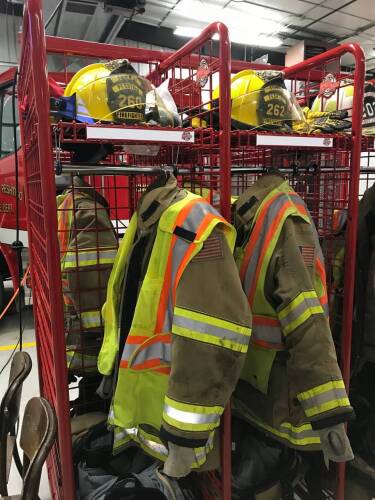By Matthew Cox
Picture that iconic portrayal of a firefighter wearing a traditional helmet and SCBA, holding a pick-head axe, maybe even with flames or an American flag in the background. A quick internet search will produce countless images like this, all with a common thread – our PPE. Without the protective coat and pants, the picture is incomplete. And really, can you even tell a firefighter from a civilian without the PPE?
ENSEMBLE EVOLUTION
PPE has evolved immensely over generations. Early versions were made of leather or rubber with liners made of felt or wool as three-quarter boots completed the ensemble. Although the image is classical and evocative, the protection the ensemble provided was far from adequate.
Our ancestors’ PPE was not difficult to understand or explain – simple fabrics that (mostly) covered the body. On the other hand, explaining the components of modern PPE to a probationary firefighter and how the gear protects us in a fire or other IDLH environment may sound like a daunting task. How many of us really understand the science behind our most vital gear?
What’s more, there are dozens of NFPA-compliant vendors, each with their own line of products. Although it may be an overwhelming process to all the many variations, a good place to start is with a high-level look at the individual PPE components. Understanding the ensemble and how the components work together provides a solid appreciation of not only how our PPE protects us but also its limitations. After all, we perform risk assessments while sizing-up a fire or other IDLH. We risk a lot to save a life. Appreciating the restrictions placed on the ensemble helps with our size-up as well. If conditions are untenable for firefighters in protective gear, the survivability profile for occupants is diminished.
3 LAYERS OF PROTECTION
Our PPE consists of three layers – the outer shell, the moisture barrier and the thermal liner – each playing a pivotal role in protecting our personnel.
- The outer shell is the most visible and our first line of defense against the environment. It will shed water and other contaminants, protecting us – and the two inner layers – from the IDLH. It also features reflective trim to meet visibility requirements on the fireground and other low-visibility situations.
- The moisture barrier, or middle layer, is a breathable layer, allowing our personnel to perspire through the garment while preventing water and other contaminants from leaching through to the skin. So while the outer shell will inhibit water and contaminants from permeating, the moisture barrier will prevent both liquid penetration and blood-borne pathogens, while still allowing for breathability.
- The inner layer, or thermal liner, provides both thermal protection from intense heat and a level of comfort for the firefighter. This layer provides most of the thermal protection. Thermal liners are made of both face cloth and batting. The face cloth protects the batting material, plays a role in moisture management (wicking moisture away from the skin) and makes the garment easy to don and doff.
GARMENT EVALUATION: TPP AND THL
The garment may be evaluated by two values: Thermal Protective Performance (TPP) and Total heat Loss (THL).
TPP is the value of the time to a second-degree burn. THL is a measure of breathability. As you might expect, as TPP values rise, THL values fall. An increase in thermal protection will allow our personnel to tolerate a more aggressive IDLH, but the THL, or breathability and moisture management, will suffer. It’s important to find a balance that works best for your members.
Understanding TPP and THL will help our members identify the capabilities of our PPE in the IDLH. Again, understanding intended use, limitations and restrictions will allow for a more thorough size-up and risk assessment both on the fireground and while preplanning our first due. A risk assessment will guide both the department and vendor through a process to design and construct the best PPE for your personnel and the firefight they will most likely encounter. Keep in mind that TPP and THL values will take on vastly different priorities based on climate and primary building construction.
PPE CLEANING AND MAINTENANCE
As important as it is to understand how the garment protects our firefighters, it is also critical to consider the significance of cleaning and maintaining PPE. NFPA 1851: Standard on Selection, Care, and Maintenance of Protective Ensembles for Structural Fire Fighting and Proximity Fire Fighting outlines advanced inspections and cleaning requirements.
At a minimum, each garment will go through an advanced inspection once a year and an advanced cleaning every six months or twice a year. However, most PPE is subjected to many fires and other hazards throughout the year. If the garment has been subjected to products of combustion, defined by the NFPA as “the end product when fuels, such as hydrocarbons and materials, remain after the process of combustion in a fire,” it will require preliminary exposure reduction, advanced cleaning and a routine inspection. Based on the definitions above, food on the stove, car fires and outside fires would all fall into the policy. Although the process is time-consuming, expensive and disruptive to our industry, following these cleaning guidelines is essential to the performance of our gear as well as the health and safety of our personnel. Contaminated gear is detrimental to the health of our firefighters, our coworkers and the citizens we serve. It is a necessary practice that we need to instill in our firefighters from the outset of their careers.
FINAL THOUGHTS
Providing firefighting gear to personnel is an expensive proposition for both small and large departments. As such, it is important that departments do whatever possible to maximize the 10-year life span of PPE. A thorough understanding of how our gear works to protect us and how to properly clean and care for it sets the stage for developing a clear maintenance program that optimizes the life and performance of the ensemble.
ABOUT THE AUTHOR
Matthew Cox has 22 years of fire service experience, currently serving as a battalion chief for the Fairfax County (Virginia) Fire and Rescue Department where he has served since 2002. Chief Cox currently supervises a battalion of five stations and approximately 60 personnel. He has served on local, regional and national committees focused on improving operational and leadership capabilities for his department and the fire service. He holds a bachelor’s degree from Virginia Tech.



